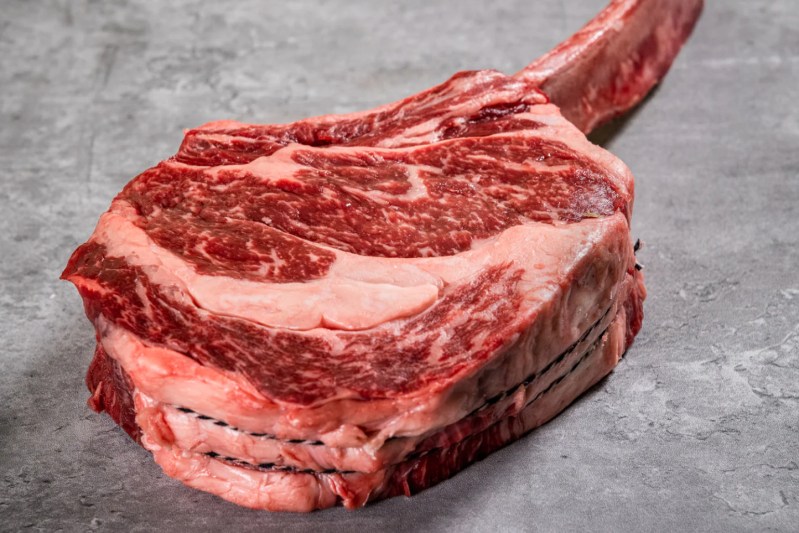
Jon Urbana, CEO and sixth-generation rancher of KOW Steaks, has some unique opinions about meat. “I hate Texas beef,” says Urbana. “I can taste it a mile away.”
While a controversial statement, Urbana knows a thing or two about beef. With ringing endorsements from culinary heavyweights like Gordon Ramsey, David Chang, and Nobu Matsuhisa, and restaurants like Strip House, Delmonico’s, The James Beard House, and Boucherie, KOW Steaks considers themselves the premier American Wagyu company. According to KOW Steaks, they were the first to bring Wagyu beef from Japan to America in the 1970s, transporting the cattle on a custom 747. With 125 years of beef experience, KOW Steak is passionate about producing beef outside of the mainstream commercial meat industry.
Currently run by Urbana and Craig Zimmerman, KOW Steaks is passionate about raising the finest quality Wagyu beef in America. From the unique cattle-raising techniques to surveying their category of beef cuts, we interviewed Urbana and KOW Steaks to learn more about what makes their American Wagyu one-of-a-kind.

What makes KOW Steaks unique
With its wide range of labels and different names, the subject of what exactly is Wagyu beef is often misunderstood by the American consumer. On many restaurant menus, the categories of “Wagyu burgers,” “Wagyu steaks,” or “Japanese Wagyu” are listed without much explanation. Is there a difference between Wagyu and Kobe? And what is American Wagyu? The most important thing to realize is in Japanese, Wagyu translates to “Japanese cattle” and includes any number of Japanese cattle, such as the infamous Kobe to Hitachi-Gyu from the Ibaraki prefecture in Japan.
For KOW Steaks, their specialty is American Wagyu. So, what’s the difference? At KOW, because these Wagyu cattle, which originally hail from Japan, are raised in America, geography and regionality play critical roles in the final flavor and marbling. Similar to how the same wine grapes can vary depending on the terroir where they’re grown, KOW’s Wagyu shares a similar dynamic. Simply put, although the Wagyu raised at KOW might originally be from Japan, they won’t taste like Wagyu in Japan.
“In my opinion, it’s all about balance; we strive to create the perfect balance between fat and flavor similar to a balanced wine or balanced whiskey,” says Urbana. “This task is incredibly hard to achieve, and we take our genetics feed water and animal husbandry very seriously to achieve this.”
Because of this focus on husbandry, KOW uses several interesting techniques cattle-raising techniques. For instance, they pay attention to fertile topsoil and use only high-quality water instead of standard watering holes for their cattle herds. Since cattle can drink up to 70 gallons of water a day, paying careful attention to the herd’s water supply is key for great beef, according to KOW.
All of this attention to detail produces clean-tasting, high-quality beef, which, as world-renowned sommelier Carlton McCoy likes to say humorously, can be a double-edged sword. “I hate serving KOW at parties,” says McCoy. “Because no one talks about the wine after tasting the wagyu.”

KOW Steaks cuts and how to use them
A quick scroll through the KOW Steaks’ website, and one can see the wide range of beef cuts available to purchase. The company carries plenty of the crowd pleasers, including ribeyes, filet, ground beef, and a showstopping “Kowboy” Tomahawk ribeye. One of the best steaks, according to KOW, is their New York Strip, a cut they like to label as their “silver bullet.”
But there’s plenty to the cow behind those delicious but well-known favorites. KOW Steaks also features underrated cuts, including the bavette steak and outside skirt, both excellent grilled quickly for Mexican carne asada or steak frites. KOW also makes beef patties, blending cuts like brisket and short ribs for a deeply beefy grind.
For longer braises or slow-roasting, KOW also has cuts like beef cheeks and whole brisket. One excellent and less well-known cut that KOW carries, especially outside Northern California, is the tri-tip. A staple of Santa Maria-style barbecue, the tri-tip has great flavor and a hearty, satisfyingly chewy meatiness.
What’s the best way to season KOW Steaks?
With all these various cuts, what’s the best way to season them? A glance at KOW Steaks and the savvy beef eater will notice that while the marbling is excellent, it’s not the same as the Japanese A5, which can be almost white from the interwoven fat. For some beef lovers, KOW Steaks pack the best of both worlds — excellent marbling but not too much where the beefiness can get lost in the fat. Because KOW is so proud of its beef’s terroir and natural flavor, they generally recommend seasoning most of their cuts with only salt, no marinade.
That being said, KOW does sell a line of meat rubs from Wassi’s & Lane’s on its website. With flavors from Classic Steak Rub to more interesting names like Spellbound Rub and Wassi’s Vintage Sunshine, use these rubs to add extra layers of flavor when needed. For instance, the Spellbound and Classic Steak Rub are great for a whole brisket or the massive Kowboy Tomahawk.
Editors' Recommendations
- Why grass-fed beef is worth the hype
- Stop ordering DoorDash: Healthy dinner ideas and tips when you work 40+ hours a week
- Climate change has caused olive oil prices to skyrocket, and there’s no end in sight
- Meet the pizza restaurant experimenting with ancient grains (spoiler alert: it’s delicious)
- This incredibly easy poached egg hack will change your eggs Benedict game forever




